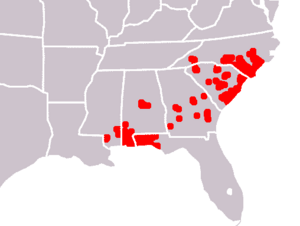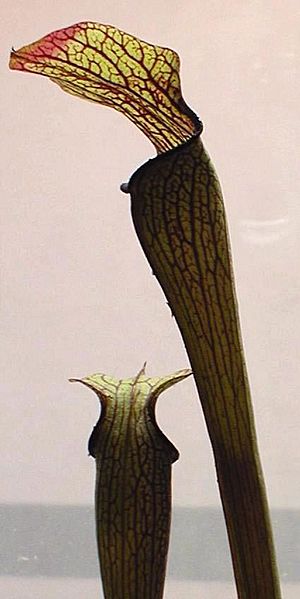Sweet pitcherplant facts for kids
Quick facts for kids Sweet pitcherplant |
|
|---|---|
 |
|
| Sarracenia rubra ssp. gulfensis | |
| Scientific classification | |
| Genus: |
Sarracenia
|
| Species: |
rubra
|
 |
|
| Sarracenia rubra range | |
Sarracenia rubra, also known as the sweet pitcherplant, is a special carnivorous plant. Like all Sarracenia plants, it grows naturally in the New World (North and South America). You can find it from southern Mississippi through southern Alabama, the Florida panhandle, and Georgia, all the way to the coastal areas of Virginia and South Carolina. This plant gets its name because its flowers often smell sweet!
Contents
How the Sweet Pitcherplant Catches Food
The sweet pitcherplant catches insects using a rolled-up leaf shaped like a pitcher. These pitchers are usually smaller and thinner than those of other Sarracenia plants, often growing up to 65 cm (26 inches) tall. Many sweet pitcherplants grow close together in groups.
The top part of the leaf opens into a lid, called the operculum. This lid stops too much rain from getting into the pitcher and washing away the plant's special digestive liquids.
The upper parts of the pitcher are covered in short, stiff hairs that point downwards. These hairs help guide insects towards the opening of the pitcher. The opening itself has a rolled edge, called a peristome, which makes a sweet liquid called nectar. This nectar attracts insects.
When insects land on the pitcher, their footing becomes very shaky. This is because the inside of the upper pitcher tube is covered in a smooth, waxy substance. Insects that lose their grip fall to the bottom of the tube. Here, a mix of digestive fluid, special wetting liquids, and more inward-pointing hairs trap them. It's very hard for them to escape! Sometimes, larger insects like wasps might chew their way out, but most get stuck.
Flowers and Reproduction
In spring, the sweet pitcherplant grows small, bright red flowers. These flowers have five parts that are the same on each side. The red petals are long and hang down over the flower's umbrella-like center, called the style. This style hangs upside down at the end of a long stem, about 50 cm (20 inches) tall.
The parts of the flower that receive pollen, called stigmata, are found at the tips of the 'spokes' of this umbrella shape. When pollinating insects, like bees, visit the flower, they usually enter from above. They push their way into the space between the petals and the umbrella, dropping any pollen they are carrying onto the stigmata.
To leave the flower, the insects usually lift a petal. This one-way system helps make sure that the plant gets pollen from other plants, which is called cross-pollination. The sweet smell of the flowers is why this plant is called the "sweet pitcherplant."
Growth Cycle
This plant changes how its pitchers look throughout the year. In spring, it often grows floppy pitchers with large "wings." This might help the plant quickly make a lot of food using sunlight (photosynthesis) at the start of the growing season. Later in summer and autumn, the plant produces much stronger and more solid pitchers.
Different Types of Sweet Pitcherplants
The way sweet pitcherplants are grouped into different types can be a bit tricky, and scientists still discuss it. Right now, there are six main types, called subspecies:
- S. rubra subsp. rubra
- S. rubra subsp. jonesii (also known as S. jonesii)
- S. rubra subsp. gulfensis
- S. rubra subsp. viatorum
- S. rubra subsp. alabamensis (also known as S. alabamensis)
- S. rubra subsp. wherryi (also known as S. alabamensis subsp. wherryi)
Some people think each of these might be its own separate species because their pitchers look different. However, their flowers are very similar, which suggests they are closely related.
See also
 In Spanish: Planta carnívora dulce para niños
In Spanish: Planta carnívora dulce para niños


